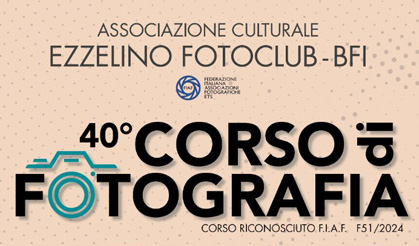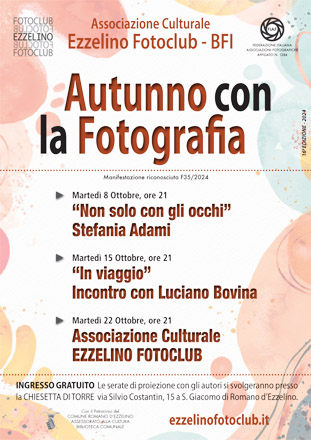Una “delegazione” del nostro club (in realtà solo la nostra socia Chiara Didonè) ha potuto visitare l’antologica di Henry Cartier Bresson presso il Centre Pompidou a Parigi. L’impressione che ne è derivata è di un evento che giustificherebbe un viaggio apposito nella capitale francese, in quanto altissimo livello e con più di 500 pezzi tra documenti e fotografie originali stampate dall’autore.
Rising signs
Henri Cartier-Bresson’s photographic work began in
the Twenties. It arose from a combination of factors:
an artistic predisposition, unremitting study,
personal ambition, a little spirit of the times,
personal aspirations and a great many encounters.
He studied under André Lhote from 1926 to 1928,
learning the classic rules of geometry and
composition. He first applied these to his painting
before experimenting with them soon afterwards
with his camera. His first pictures are thus often
structured according to the proportions of the
Golden Section. Thanks to his American friends
Caresse and Harry Crosby, he discovered Eugène
Atget’s photographs of oldParis. Starting in the
autumn of 1930, he spent a period inAfricawhere he
applied the formal innovations of the New Vision in
photography, inherited from Russian Constructivism:
unusual angles, extremely close-up shots and
an attention to dynamics. A far cry from
the ethnographer’s point of view, these pictures
are marked by the rhythm of Africans’ daily lives.
The attraction to Surrealism
Through René Crevel, whom he met at the home
of Jacques-Émile Blanche, Cartier-Bresson began
to mingle with the Surrealists in around 1926.
The elements of chance and coincidence that
Cartier-Bresson included in his compositions,
like the movement captured in his shots, all evinced
his sympathy with this movement, although he was
never an official member of it. However, he regularly
attended the meetings of the group’s members.
From these associations, he retained a number
of motifs emblematic of the Surrealists’ world,
like wrapped objects, deformed bodies and dreamers
with closed eyes. But he was even more influenced
by the Surrealist attitude: the subversive spirit,
a liking for games, the importance given to the
subconscious, the joy of strolling through the streets,
and lightning speed.
A militant commitment
Like most of his Surrealist friends, Cartier-Bresson
shared many of the Communists’ political positions:
a fierce anti-colonialism, an unswerving commitment
to the Spanish Republicans and a profound belief
in the need “to change life”. His first photo-reports,
commissioned by the Communist press, dealt with
social subjects like the first paid holidays in 1936, or
paid tribute to Party ideals, like “childhood”. He also
covered political meetings. During the coronation
of George VI in May 1937, he mischievously turned
his back on the sovereign and pointed his camera
at the people looking at him.
Cinema and the war
Cartier-Bresson’s experience in films contributed
to his political commitment. Between 1935 and 1945,
he abandoned photography for film, whose narrative
structure made it possible to reach a wider audience.
In theUSin 1935, he learned the basics of using
a film camera from a cooperative of documentary
makers, led by Paul Strand, who were highly inspired
by Soviet political ideas and aesthetics. The name
of the group was “Nykino”, from the initials of
New Yorkand the Russian word for cinema. On his
return toParisin 1936, he began a collaboration with
Jean Renoir that lasted until the war. He enlisted
in the Film and photography sections of the French
Troisième Armée during the Second World War, and
spent three years as a prisoner before escaping and
joining a group of Communist resistance fighters.
Between 1944 and 1945, he filmed and photographed
documentary images of the ruins of the village of
Oradour-sur-Glane, the liberation ofParisand
the return of prisoners fromGermany.
The decision to become a photojournalist
The retrospective devoted to Cartier-Bresson by
the MoMA inNew Yorkin February 1947 marked
the institutional recognition of his creative genius.
The same year, he cofounded the cooperative
Magnum Photos, and focused on photojournalism.
From then on, he accepted the constraints of the job,
in terms of technical requirements and the topicality
of the subjects. His pictures were published in
magazines all over the world until the early
Seventies. Some made a particular impression
on the public, like the crowd of Indians in mourning
during Gandhi’s funeral, or the “gold rush” of
the Chinese. On the sidelines of these events, he also
showed people’s daily lives in different countries:
inRussiaafter Stalin’s death, inCubain 1963, and
inFranceafter the disturbances of May 1968.
Visual anthropology
In every country he visited for his reports,
Henri Cartier-Bresson observed and photographed
recurring themes and shared attitudes resulting
from the upheavals in society after 1945. Like an
anthropologist, in direct contrast to the pace and
constraints imposed by the press, he carried out
a number of surveys focused on certain themes
across the board throughout the world.
These reflected his pre-war interests and
obsessions: choreography and the depiction
of bodies in cities, the relationship between men
and machines, the representation of power in public
space, signs of the consumer society and those
involved, and crowds – the embodiment of
the revolutionary spirit, and also a highly stimulating
exercise in photographic composition.
After photography
From the Seventies onwards, Cartier-Bresson began
to distance himself from Magnum and gradually
stopped taking commissions for photo-reports.
While he did not abandon his Leica, his style became
more collected and contemplative. The landscapes,
portraits of friends and objects in his personal life
that he captured on film evoke the poetic spirit of
his early pictures. In a similar return to his roots,
he went back to drawing, sketching in the open air or
from life. He spent a great deal of time supervising
the organisation of his archives, sales of his prints
and the production of books and exhibitions.
Slowness and observation imbue this final period
in the work of an artist whose keen eye produced
magnificent results, in every facet of his career
and in every medium he used.
Henri Cartier-Bresson
1908 Henri Cartier-Bresson is born on 22 August
in Chanteloup-en-Brie.
1926-1928 René Crevel introduces him
to the Surrealists. He attends several meetings of the group,
whose members have joined the Communist party.
He studies at the academy of painter André Lhote.
1929 He becomes friends with the American couple
Harry and Caresse Crosby. At their home, Cartier-Bresson
meets up with André Breton and Salvador Dalí again.
He gets to know publishers, gallery owners and collectors,
including Julien Levy. He learns about the formal innovations
of American Straight Photography and the European
New Vision.
1930-1932 Cartier-Bresson sets off forAfrica.
On his return, he goes on a journey toEastern Europe,
then travels toItalywith his first Leica.
1933 He begins to mingle with the AEAR (association
of revolutionary writers and artists) inParis. He visits
a number of cities inSpain, and carries out his first
photo-reports for the press.
1934 After the February riots inParis, he signs two
anti-Fascist tracts. In June, he begins a year-long stay
inMexico, mixing with artists and intellectuals who have
close ties with the National Revolutionary Party then
in power.
1935 He goes toNew York to take part in the exhibition
“Documentary and Anti-Graphic Photographs by
Cartier-Bresson, Walker Evans & Álvarez Bravo”
at Julien Levy’s gallery. He becomes involved with Nykino,
a cooperative of militant pro-Soviet film directors.
In May and June, he participates in the exhibition
“Documents de la vie sociale” staged by the AEAR inParis.
He gradually focuses on films more than photography.
1936-1939 Cartier-Bresson meets Jean Renoir.
He becomes his assistant on La vie est à nous, commissioned
by the Communist Party. He collaborates on Partie
de campagne and La Règle du jeu, and works regularly
for the Communist press. In 1937, he marries the Indonesian
dancer Carolina Jeanne de Souza-Ijke, known as Eli
(they divorce in 1967). A member of the Ciné-Liberté
cooperative (the film section of the AEAR), Cartier-Bresson
produces his first documentary, Victoire de la vie,
on the Spanish Civil War.
1940-1945 He enlists in the “Film and photography”
section of the Troisième Armée. He is taken prisoner,
but escapes in 1943, and withAragon’s help joins a group
of Communist resistance fighters, the future MNPGD
(National Movement for Prisoners of War and Deportees).
He becomes its official representative in the Comité
de Libération du Cinéma and is put in charge of organising
a Comité de Libération dela Photographiede Presse.
In 1945, the Office of War Information and the MNPGD
assign him to direct a film on the repatriation of prisoners
(Le Retour).
1947 First retrospective at the MoMA. He founds
the Magnum Photos cooperative with Robert Capa,
George Rodger, David Seymour and William Vandivert.
His photo-reports appear in numerous magazines like Life,
Holiday, Illustrated and Paris Match. In December,
he travels toIndiawith Eli, shortly after the Declaration
ofIndependence.
1948 He meets Gandhi, just before his assassination.
His photographs of the funeral are published by Life.
Then he travels toBeijingjust when the People’s Liberation
Army led by Mao Zedong is on the brink of toppling
Chang Kai-shek’s Nationalist government.
1952 He publishes his first book with the art critic
and publisher Tériade: Images à la sauvette or
The Decisive Moment in the American version.
1954-1955 Danses àBali is published with
a foreword by Antonin Artaud. Cartier-Bresson travels
toMoscow, as the first Western reporter to enter
the URSS since 1947.
In 1955, he takes part in the exhibition “The Family of Man”
at the MoMA. The Musée des Arts Décoratifs de Paris
devotes a retrospective to him. He publishes Les Européens
with Tériade.
1963-1965 He travels toCuba, then spends several
months inJapan.
1966 He meets the photographer Martine Franck,
whom he marries in 1970.
1968-1974 After May 1968, he begins a report
on his compatriots: Vive la France. From 1974 onwards,
he gradually abandons photojournalism in favour of portrait
and landscape photography, and the promotion of his work.
He takes up drawing again.
1979 The book Henri Cartier-Bresson: photographe is
published to accompany the eponymous travelling exhibition.
1980 The Musée d’Art Moderne dela Ville de Paris
presents the exhibition “Henri Cartier-Bresson:
300 photographies de 1927 à 1980″.
2003 The Bibliothèque Nationale de France presents
the retrospective “De qui s’agit-il?”
The Fondation Henri Cartier-Bresson is created inParis.
2004 Henri Cartier-Bresson dies on 3 August
in Montjustin.






